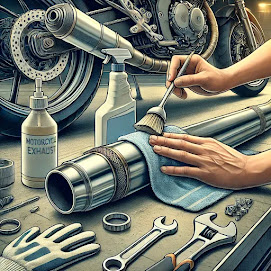If your motorcycle spark
plug is damaged or dirty, there are several steps you can take to fix it. Here
are ways to fix the problem of damaged or dirty spark plugs:
Cleaning Dirty Spark Plugs, If the spark plug is only dirty, you can clean it
first before deciding to replace it. Here are the steps:
Tools Needed:
Spark plug wrench
Small wire brush or old toothbrush
Cleaning fluid (such as gasoline, carburetor cleaner, or other cleaning fluid)
Clean cloth
Steps:
Turn off the Engine and Remove the Battery: Make sure the motorbike is off, and
remove the battery to prevent electric shock while you are working.
Remove the Spark Plug:
Use a spark plug wrench to remove the spark plug from its place. Turn the spark
plug carefully until it comes off.
Check the Condition of
the Spark Plug: See if there is any dirt, crust, or sediment on the spark plug.
If the spark plug is only dirty, you can clean it.
Clean the Spark Plug:
Use a wire brush or old toothbrush to scrub the dirt or crust that sticks to
the tip of the spark plug. If the crust is very stubborn, you can soak it in
cleaning fluid for a few minutes before brushing it.
Check the Spark Plug
Gap: After cleaning, check the spark plug gap using a feeler gauge. The right
gap is important to produce optimal sparks. If the gap is too large or small,
you can adjust it with a special tool.
Reinstall the Spark
Plug: After the spark plug is clean and the gap is correct, reinstall the spark
plug into your motorcycle's ignition chamber and tighten it by hand, then use a
spark plug wrench to ensure proper installation.
Replacing a Damaged Spark Plug
If after checking the spark plug it turns out to be damaged (for example, worn
electrodes or cracks), you need to replace it with a new one. Here are the
steps to replace the spark plug:
Steps:
Turn off the Engine and Remove the Battery: Make sure the motorbike is off and
remove the battery for safety.
Remove the Old Spark
Plug: Use a spark plug wrench to remove the old spark plug. Turn it slowly and
carefully until the spark plug is released from the ignition chamber.
Check Spark Plug
Condition: If the spark plug is damaged or worn, make sure you replace it with
a new spark plug that matches your motorcycle type.
Install New Spark Plug:
Insert the new spark plug into the ignition chamber carefully. Make sure the
spark plug is installed perfectly and tighten it using a spark plug wrench.
Check Spark Plug Gap:
Make sure the spark plug gap on the new spark plug is according to the
manufacturer's recommendations. You can adjust the gap using a feeler gauge.
Test the Motor: After
replacing or cleaning the spark plug, start the engine to make sure the spark
plug is working properly.
To prevent the spark plug from getting dirty or damaged quickly, do the
following:
Check the Spark Plug Regularly: Check the spark plug regularly, for example
every 5,000 km or according to your motorcycle service schedule.
Use Quality Fuel: Use
clean and quality fuel so as not to cause rapid carbon buildup on the spark
plug.
Check the Ignition System: Make sure your motorcycle's ignition system is
working properly, because problems with the ignition system can cause the spark
plug to get dirty or damaged quickly.
If you are in doubt
about the condition of the spark plug or if the spark plug is consistently
dirty or damaged, it is best to consult a mechanic for further inspection.
Risks and maintenance of automatic motorcycle belting
Automatic motorcycle belting
maintenance is very important to maintain the performance and lifespan of the
component. Here are some maintenance tips for automatic motorcycle belting:
Routine Inspection
Check the condition of the belt
regularly, at least every 5,000 km or according to the manufacturer's
recommendations. Check for signs of wear such as cracks, splits, or uneven
wear.
Clean the Belt
Dust and dirt can reduce the
efficiency of the belt's performance. Wash the belt regularly with a dry cloth
or spray it with low-pressure air to remove dirt.
Tension Check
Make sure the belt tension is
according to the manufacturer's specifications. A belt that is too tight or
loose can cause premature wear and reduce performance.
Avoid Overload
Do not often carry excessively heavy
loads or drive aggressively, as this can increase the load on the belt and
reduce its service life.
Check Other Components
Also check related components such
as pulleys (gears) and rollers, because damage to these components can affect
belt performance.
Replace Belts Regularly
Even though the belt still looks
good, make sure to replace it according to the manufacturer's maintenance
schedule. Usually, automatic motorcycle belts need to be replaced every 15,000
- 20,000 km, depending on the type and conditions of use.
By carrying out proper maintenance, automatic motorcycle belts will last longer and the motorcycle will remain optimal in operation.























